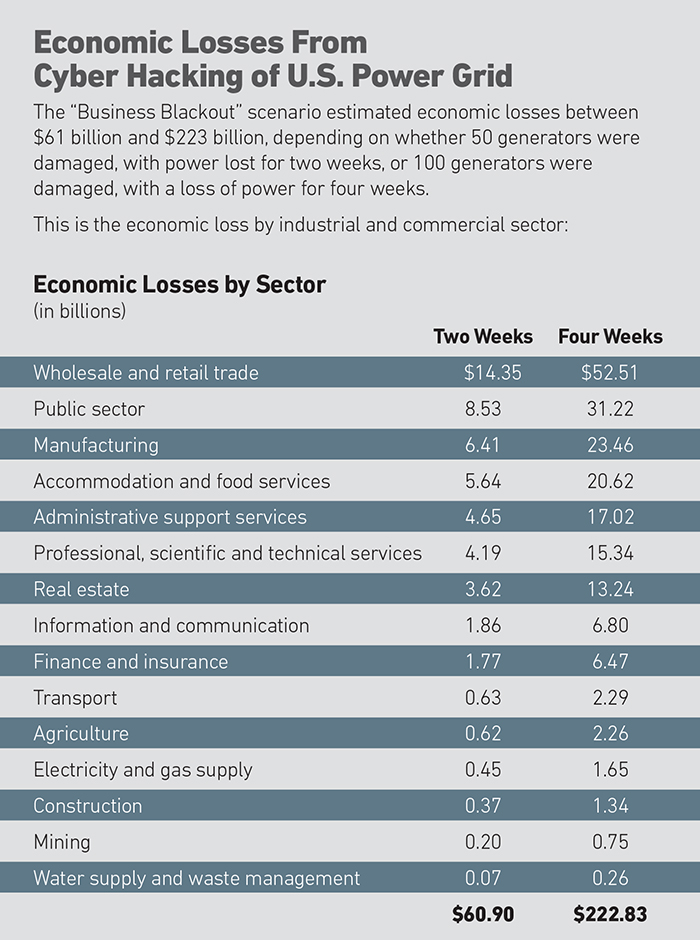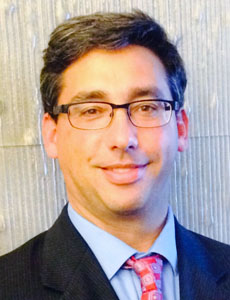2016 Most Dangerous Emerging Risks
Cyber Grid Attack: A Cascading Impact

SCENARIO: The hackers used a range of tactics to gain access to the U.S. electric grid system without alerting security teams — targeting laptops and personal electronic devices of key personnel, conducting phishing attacks, hacking remote access systems and physically intruding on network monitoring locations.
Months later, they systematically disabled safety systems that would prevent power generators from being desynchronized. They sent control signals to open and close the generator’s rotating circuit breakers in quick succession.
This used the inertia of the generator itself to force out of sync the bearings of 50 generators. They had hoped to destroy 100.
The generators began to smoke and burn. Some were partially destroyed. One gas turbine facility exploded from the generator fire. Operators shut down even the uncontaminated generators until the cause of the damage was determined.
The cascading impact of the cyber attack stuns the nation. Engineers have no definitive explanation for the damage, which plunges 15 Northeastern states and Washington, D.C. into darkness, leaving 93 million people without power.
Back-up generators at hospitals, public facilities and some companies remain available for essential services. Phones, internet, ATMs, street lights, subway cars, gas stations, water systems, manufacturers, and just about everything else goes down. Communications systems are mostly unavailable, except for 911.
No one immediately knows the scope of the infection. Or whether it will reoccur.
VIDEO: Media reports highlight the vulnerability of the U.S. power grid.
ANALYSIS: This “Business Blackout” scenario by the University of Cambridge Centre for Risk Studies and Lloyd’s of London suggests a range of $61 billion to $223 billion in economic losses, depending on the number of impacted generators and whether it took two, three or four weeks to restore 90 percent of the power.
“This is a real risk management issue facing the power sector around the world right now,” said Nick Beecroft, emerging risks and research manager, Lloyd’s of London, who worked on the “Business Blackout” project.
But even more, he said, it is a risk that “all of society has to confront as more and more of our infrastructure and economy become connected to digital networks.”
Such an attack “would disrupt businesses spanning the entire economy.” In the scenario, it takes several months and up to three years for the economy to fully revert to the GDP levels prior to the attack.
One insurance executive who asked to remain anonymous said it’s impossible to calculate the cascading impact of a cyber attack on the power grid.
“The honest answer is we don’t know,” the executive said. “It’s difficult to say if this is a one-in-100-year event or a one-in-10-year event. How do we know it won’t happen tomorrow or twice in a week? That’s the scary part for us.”
“Cyber is definitely the most dangerous emerging risk. The digital infrastructure was not designed to protect against bad guys.” —Andrew Coburn, senior vice president, RMS; director of the advisory board at the Cambridge Centre for Risk Studies
In 2003, overgrown tree limbs short-circuited sagging transmission lines amid hot weather in Ohio that had already strained generating capacity. Combined with human error, the result was a blackout of eight states and part of Canada for 36 hours, affecting 50 million people.
“I think that shows how interconnected the power grid is,” said Jamie Bouloux, president, cyber practice, Ryan Specialty.
Utilities Are “Under Constant Attack”
“The utilities, energy and infrastructure industries — petroleum, gas, electric power, nuclear, renewable, telecoms, water and sewage — are under constant attack,” said Kevin Kalinich, national cyber leader, Aon Risk Solutions.
The “poster child” for sophisticated nation-state hacks is Stuxnet, where unnamed hackers generally believed to be the United States and Israel introduced malware into Iran’s industrial control systems, causing nuclear centrifuges to spin out of control and damage themselves even while displays indicated normal functioning.
The controllers used in Iran are the same as those used in U.S. military systems, power plants, water systems, transportation, manufacturing and other commercial and industrial enterprises, said cyber security expert Joe Weiss, managing director of Applied Control Solutions.
“There are only 10 to 15 vendors [of control systems] worldwide and they supply every industry.”
And they are vulnerable, he said.
“It is possible to compromise the power grid via a cyber attack. Depending on the attack, it is possible to bring the grid down for nine to 18 months. This is existential to the United States.
“Nation-states are actively targeting our critical infrastructure and actively trying to compromise control systems,” Weiss said. “We know that.
“Not much is being done and the cyber insurance world needs to understand the cyber risks to these critical control systems.”
Security Has Increased
Utilities have been working to better secure infrastructure, including the grid and their distribution and transmission networks, said Gary Gresham, senior vice president, power practice, Aon Global Power.
In 2012, $14 billion was spent to shore up grid reliability and redundancy. That’s compared to about $5 billion spent in 2003.
 Utilities and power generators are also working in conjunction with local law enforcement, Homeland Security and the FBI to share information on the types of attacks seen.
Utilities and power generators are also working in conjunction with local law enforcement, Homeland Security and the FBI to share information on the types of attacks seen.
But the utility industry is more advanced in protecting their systems and sharing information than other sectors of the country, including transportation, communications, industrial and manufacturing, which also rely on industrial control systems, Gresham said.
Tim Francis, enterprise cyber lead, Travelers, noted that insurers and the private sector have dealt with the threat of data breaches for a while, but are “just beginning the journey” on threats to industrial control systems.
For businesses, it may come down to a question of size and scale, said Bouloux.
“Ultimately, if you are a big enough business, you should be able to marginalize the exposure due to a power outage,” he said.
Experts often compare the impact of a power grid hack to the damage and losses resulting from large natural disasters such as Katrina and Sandy, but Bouloux said 9/11 might be a better model for understanding the economic impact such an event could have on the insurance industry, if it was found to be an act of terrorism.
Commercial claims in the New York area alone were varied and complicated — amounting to about $40 billion, of which an estimated $27 billion was paid in claims associated with business interruption, liability and property damage (other than damage to the World Trade Center buildings), he said.
As a single, isolated act of terrorism, it calls into question Lloyd’s estimated insured losses from the 15-state blackout scenario of $21.4 billion to $71.1 billion.
The cascading impact of a cyber attack complicates the picture for insurers.
“They need to look at how many insureds’ policies they have that have certain coverages on them,” said Andrew Coburn, senior vice president, RMS, and director of the advisory board at the Cambridge Centre for Risk Studies.
“About 12 classes of insurance lines were impacted in the scenario,” he said.
The formula to determine potential losses is complex, often depending on whether companies have “supplier’s extension coverage,” which may have ambiguous wording relating to perils.
To come up with a potential loss, the insurance companies need to work through how long each insured is impacted — which could range from one to four weeks or more — and then take into account deductibles, limits and sublimits, Coburn said.
“We spent the past couple of months working with insurance companies to apply this to their book as a stress test scenario,” he said. “It’s not the easiest one for them.”
Risk Mitigation
Regardless of whether a power outage is due to a natural event or a cyber attack, companies need to prepare in similar ways, Francis said.
They need back-up continuity plans, plans for employees working offsite, and they
need to talk to their broker and insurer prior to any such event to determine what is covered and what gaps exist.
Experts said coverage is available to cover most exposures related to a power-grid attack, but one policy alone will probably be insufficient. For example, power
outages are generally not covered by insurance policies — such as for property coverage — unless there is physical damage.
When planning for continuity, risk managers should look at the electric grid and ensure they have facilities in other grids so those facilities would not be affected, Bouloux said.
Effective mitigation requires an ongoing review of potential exposures from an enterprise risk management perspective, said Gresham.
Risk managers must continually review and update processes and practices to ensure the organization is as resilient as possible and operations have redundancy.
Aon’s Kalinich said it’s possible for insureds to identify and quantify their business interruption losses on a micro level. “The bigger question,” he said, “is the macro level aggregated risk of grid-type exposures” for insurance companies.
“For us, it’s not an academic exercise,” Beecroft of Lloyd’s said. “It’s a real challenge for the industry. We have to be able to pay out claims.
“We recognize that there is a large degree of ambiguity and uncertainty about whether or not existing insurance covers would respond in the event of a cyber event.”
Managing the risk requires a partnership of government, insurance and business, he said. “We can’t just accept the vulnerability and throw our hands up. We can manage to make life difficult for hackers, but we can’t reduce the risk to zero.”
“Cyber,” said Coburn, “is definitely the most dangerous emerging risk. The digital infrastructure was not designed to protect against bad guys. It was designed to be efficient. … What is society willing to spend to make that threat go away?” &
2016’s Most Dangerous Emerging Risks
 The Fractured Future Infrastructure in disrepair, power grids at risk, rampant misinformation and genetic tinkering — is our world coming apart at the seams?
The Fractured Future Infrastructure in disrepair, power grids at risk, rampant misinformation and genetic tinkering — is our world coming apart at the seams?
 Crumbling Infrastructure: Day of Reckoning Our health and economy are increasingly exposed to a long-documented but ignored risk.
Crumbling Infrastructure: Day of Reckoning Our health and economy are increasingly exposed to a long-documented but ignored risk.
 Fragmented Voice of Authority: Experts Can Speak but Who’s Listening? Myopic decision-making fostered by self-selected information sources results in societal and economic harm.
Fragmented Voice of Authority: Experts Can Speak but Who’s Listening? Myopic decision-making fostered by self-selected information sources results in societal and economic harm.
 Gene Editing: The Devil’s in the DNA Biotechnology breakthroughs can provide great benefits to society, but the risks can’t be ignored.
Gene Editing: The Devil’s in the DNA Biotechnology breakthroughs can provide great benefits to society, but the risks can’t be ignored.
















